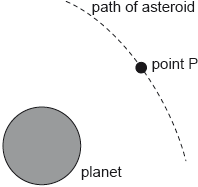| Date | May 2019 | Marks available | 3 | Reference code | 19M.2.HL.TZ1.5 |
| Level | Higher level | Paper | Paper 2 | Time zone | 1 |
| Command term | Show that | Question number | 5 | Adapted from | N/A |
Question
The moon Phobos moves around the planet Mars in a circular orbit.
Outline the origin of the force that acts on Phobos.
Outline why this force does no work on Phobos.
The orbital period T of a moon orbiting a planet of mass M is given by
where R is the average distance between the centre of the planet and the centre of the moon.
Show that
The following data for the Mars–Phobos system and the Earth–Moon system are available:
Mass of Earth = 5.97 × 1024 kg
The Earth–Moon distance is 41 times the Mars–Phobos distance.
The orbital period of the Moon is 86 times the orbital period of Phobos.
Calculate, in kg, the mass of Mars.
The graph shows the variation of the gravitational potential between the Earth and Moon with distance from the centre of the Earth. The distance from the Earth is expressed as a fraction of the total distance between the centre of the Earth and the centre of the Moon.
Determine, using the graph, the mass of the Moon.
Markscheme
gravitational attraction/force/field «of the planet/Mars» ✔
Do not accept “gravity”.
the force/field and the velocity/displacement are at 90° to each other OR
there is no change in GPE of the moon/Phobos ✔
ALTERNATE 1
«using fundamental equations»
use of Universal gravitational force/acceleration/orbital velocity equations ✔
equating to centripetal force or acceleration. ✔
rearranges to get ✔
ALTERNATE 2
«starting with »
substitution of proper equation for T from orbital motion equations ✔
substitution of proper equation for M OR R from orbital motion equations ✔
rearranges to get ✔
or other consistent re-arrangement ✔
6.4 × 1023 «kg» ✔
read off separation at maximum potential 0.9 ✔
equating of gravitational field strength of earth and moon at that location OR ✔
7.4 × 1022 «kg» ✔
Allow ECF from MP1
Examiners report
This was generally well answered, although some candidates simply used the vague term “gravity” rather than specifying that it is a gravitational force or a gravitational field. Candidates need to be reminded about using proper physics terms and not more general, “every day” terms on the exam.
Some candidates connected the idea that the gravitational force is perpendicular to the velocity (and hence the displacement) for the mark. It was also allowed to discuss that there is no change in gravitational potential energy, so therefore no work was being done. It was not acceptable to simply state that the net displacement over one full orbit is zero. Unfortunately, some candidates suggested that there is no net force on the moon so there is no work done, or that the moon is so much smaller so no work could be done on it.
This was another “show that” derivation. Many candidates attempted to work with universal gravitation equations, either from memory or the data booklet, to perform this derivation. The variety of correct solution paths was quite impressive, and many candidates who attempted this question were able to receive some marks. Candidates should be reminded on “show that” questions that it is never allowed to work backwards from the given answer. Some candidates also made up equations (such as T = 2𝝿r) to force the derivation to work out.
This question was challenging for candidates. The candidates who started down the correct path of using the given derived value from 5bi often simply forgot that the multiplication factors had to be squared and cubed as well as the variables.
This question was left blank by many candidates, and very few who attempted it were able to successfully recognize that the gravitational fields of the Earth and Moon balance at 0.9r and then use the proper equation to calculate the mass of the Moon.


